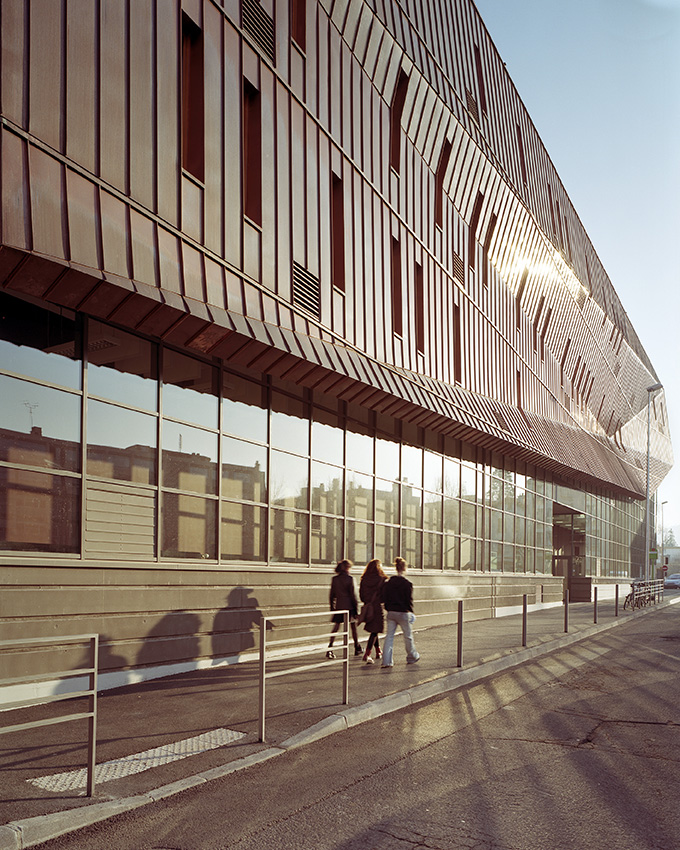The School’s post-baccalaureate educational programme leads to 2 state-certified qualifications – Art option: the Bachelor’s degree Diplôme National d’Art (DNA) obtained after three years, and the Master’s degree Diplôme National Supérieur d’Expression Plastique (DNSEP) obtained after five years.
The School’s educational programme is compliant with the European framework for higher education and the European Credit Transfer System (ECTS). This ensures perfect alignment with the Europe-wide higher education network. DNA and DNSEP allow students to enter all European universities at a direct equivalent level.
CURRICULUM
FIRST CYCLE
Year one
Outline
The first year of an art school course is a switchover year. It often comprises a break from the learning systems with which students are familiar, and looks towards artistic practices which are built up and discussed. Students have to connect their first artistic intuitions to a critical and personal approach to the world.
During this year, students gauge whether they have the aptitude to commit to an art course lasting several years. The programme allows for learning about the essentials, both creative and theoretical, whilst preparing to study. It creates a basis of autonomy with regard to working and thinking.
Course content
The history and theory of art: contemporary art, art history, literature, philosophy
An introduction to techniques and practices: sculpture, photography, video, printing, desktop publishing, live model/figure drawing, cinema, digital arts, painting, etc.
Methodology of documentary research
English
…
Objectives
The first year invites students to become involved in artistic culture and to discover the approaches and languages implemented in contemporary design.
The educational programme enables students:
to acquire technical bases, essential know-how and design tools
to start developing a work methodology
to build capacities for formal and critical analysis
to engage fully with the projects managed and put forward by teachers, so as gradually to define their own relationship with the world
Years 2 and 3
Outline
The Programme phase covers Years 2 and 3, leading students to the Diplôme National d’Art (DNA) – Art option. These two years form a single teaching module in which students gradually learn to express themselves critically and artistically and become able to research and experiment independently.
Course content
The history and theory of art: contemporary art, art history, philosophy, literature
Methods, techniques and applications: sculpture, photography, video production and editing, cinema, film criticism, digital art, painting, installation art, etc.
Researches and personnal experimentations,
Research and creativity workshops, themed laboratories
Essay’s methodology and documentary research
English
Objectives
Building on basic artistic skills, the Programme phase aims to:
Expose students to the issues of contemporary artistic creation
Allow students to experiment in different plastic arts media
Provide students with a solid grounding in design tools, techniques and technologies
Divided into 4 semesters, the curriculum aims to give students a working method allowing them to follow their own way. This method is progressive and suited to the student’s personality and evolution. It allows
him / her to go from:
thematic questioning to the definition of a personnal problematics,
mastery of the tool to its appropriation,
practice to creative path, then to production
DNA – Bachelor’s degree
Examinations
In the 30 minutes allotted, students give a spatial presentation of a creative project together with a selection of creative works and a written piece selected from those produced during the 3rd year of the course.
A panel of 3 members, appointed by the Director of the establishment, one of whom represents the human sciences. The panel is composed of:
Two qualified artists or art professionals from outside the School, one of whom is designated chairman of the panel
One teacher from the School
Obtaining the DNA qualification is just a requisite requirement (among others for entry to the 4th year).
Entry to the Project phase is also dependent on the opinion of the entry Committee during the 2nd cycle.
Assessment criteria
The way the work is presented
How the project originated and how it evolved. The research and production phases are evaluated
How well the student has adopted, understood and assimilated the cultural references
The quality of the work produced
Taken at the end of the third year, the Diplôme National d’Art (DNA) allows students to enter university. The Diplôme National d’Art comprises three tests: an examination of the student’s academic profile and results, a presentation by the student of a selection of significant works done during the three years of studies, an interview with the examining committee.

SECOND CYCLE
Years 4 and 5
Outline
The Project phase covers Years 4 and 5 of the programme, corresponding to the second level of higher education in art, and leads to the Diplôme National Supérieur d’Expression Plastique (DNSEP).
Students experiment with the most diverse means of plastic expression. They gain understanding of theory and history and are widely exposed to contemporary issues. This leads each student through the process of creating a personal project expressing his or her vision of the world.
During this phase, students follow two parallel paths: one opening onto the outside; the other leading to a deeper level of personal investigation.
In Year 4, emphasis is placed on mobility, experimentation, opening out, and research. In Year 5, students are encouraged to refocus their research and develop their personal expression. The shape, order and pace of learning depend on groups and individuals and the opportunities that arise.
Course content
« Meeting point » (dynamic, crossover approach with regard to practice and theory) contemporary art, philosophy, literature, participation in seminars
Vision, methodology and implementation of a personal plastic art project
Research and creativity workshops, themed laboratories and research projects
Realities of arts
English
Objectives
During the « Phase projet », numerous things are at stake. It aims to help students to:
optimize their theoretical, technical and practical skills,
build a personal search and commitment, inscribed within the multiple and open framework of contemporary art,
achieve an autonomous conception and realization; ensure the professional quality of their production; acquire
an acute sense of how their work will be exhibited and received
DNSEP – MASTER’S DEGREE
Examinations
Presentation of an essay
Presentation of a plastic art research: physical presentation of a selection of personal work and critical presentation of the approach taken
In the 40 minutes allotted, students must present their plastic art research project to a five-member panel appointed by the Director of the School. The panel consists of:
Four qualified artists or art professionals from outside the School, one of whom is designated chairman of the panel
One teacher from the School
The essay is presented in 20 minutes to a teacher from the School and one of the qualified artists or art professionals. One of the two assessors must hold a doctorate.
Assessment criteria
Formal and critical presentation of project
Formation of project and research process
Positioning the work (relevance of reference works, range of knowledge)
Quality of work produced
